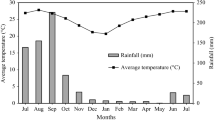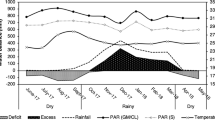Abstract
West African livestock keepers need forage sources to feed animals without degrading the local fragile ecosystems. Establishing high-density forage protein banks for animal feeding was evaluated in three contrasting zones of Burkina Faso. The agronomic performance of the fodder species Leucaena leucocephala (leucaena) and Morus alba (mulberry), planted for intensive forage production (25,000 plants/ha) was monitored through plant height (HEI), stem diameter (DIA), branch number (BrN) and branch length (BrL). Once plots were considered established (at 7 months) all trees were coppiced. Biomass yield subsequently was monitored over three bi-monthly harvests which began approximately 1 year after planting. For both species, a highly significant interaction between experimental site and dates was observed for all variables except BrN. Average HEI (103 cm) were similar. DIA (7 ± 0.4 cm) and BrL (55 ± 2.2 cm) were higher in mulberry (6 ± 0.1 and 29 ± 1.0 cm, respectively), whereas the BrN remained higher in leucaena (7 ± 0.2 vs. 2 ± 0.1 cm). No differences were observed in HEI between sites from June to August. However, from September to October, both species displayed a stronger growth rate at site 1. The biomass yields (t DM/ha/year) in three consecutive harvests were lower than values reported in other tropical regions (1.8 ± 1.2 and 8.1 ± 3.9, for mulberry and leucaena, respectively). Differences between sites were due mainly to soil properties, rainfall pattern and termite attacks. This study demonstrated that L. leucocephala and M. alba, planted in high-density forage banks, successfully establish and have high forage yield across several edaphoclimatic conditions in Burkina Faso. Our findings suggest that this technology could significantly contribute to livestock feeding systems in the region, thus reducing negative effects of over-grazing on landscape degradation.








Similar content being viewed by others
References
Bationo BA, Kalinganire A, Bayala J (2012) Potentialités des ligneux dans la pratique de l’agriculture de conservation dans les zones arides et semi-arides de l’Afrique de l’Ouest: Aperçu de quelques systèmes candidats.ICRAF. Technical Manual, No 17. World Agroforestry Centre, Nairobi
Bayala J, Ky-Dembele C, Kalinganire A, Olivier A, Nantoumé H (2014) A review of pasture and fodder production and productivity for small ruminants in the Sahel. ICRAF occasional paper no. 21. World Agroforestry Centre, Nairobi
Benavides I (1995) Manejo y utilización de la morera (Morus alba) como forraje. Agrofor Am 2(7):27–30
Bernoux M, Chenu C, Blanchart E, Eglin A, Bispo T, Bardy M, King D (2011) Le programme GESSOL 2: impact des pratiques agricoles sur les matières organiques et les fonctions des sols. Etude et Gestion des Sols 18(3):137–145
Bertrand G (2009) Caractérisation des réponses adaptatives a la contrainte hydrique dans le Sud-Est de l’Amazonie chez trois: espèces fourragères cultivées en monoculture et en association: Brachiaria brizantha, Leucaena leucocephala et Arachis pinto. Thèse de doctorat, Université Paris-Est. https://tel.archives-ouvertes.fr/tel-00504177
Brandt M, Hiernaux P, Kjeld R, Cheikh M, Laurent K, Torbern T, Yahaya ZI, Abdoulaye W, Compton JT, Rasmus F (2016) Assessing woody vegetation trends in Sahelian drylands using MODIS based seasonal metrics. Remote Sens Environ 183:215–225
Bray RH, Kurtz LT (1945) Determination of total, organic, and available forms of phosphorus in soils. Soil Sci 59:39–45
Brewbaker JL, Hegde N, Hutton EM, Jones RJ, Lowry JB, Moog F, van den Beldt R (1985) Leucaena forage production and use. Hawai, NFTA, p 39
Chotchutima S, Tudsri S, Kangvansaichol K, Sripichitt P (2016) Effects of sulfur and phosphorus application on the growth, biomass yield and fuel properties of leucaena (Leucaena leucocephala (Lam.) de Wit.) as bioenergy crop on sandy infertile soil. Agric Nat Res 50:54–59
Datta RK (2000) Mulberry cultivation and utilization in India. FAO Electronic conference on mulberry for animal production (Morus L.). http://www.fao.org/DOCREP/005/X9895E/x9895e04.htm#TopOfPage. Accessed 20 Sept 2017
Filho JM (2015) Fisiologia de Sementes de Plantas Cultivadas. Londrina, PR: Associação Brasileira de Tecnologia de Sementes - ABRATES, ISBN: 978-85-64895-03-4
Franzel S, Carsan S, Lukuyu B, Sinja J, Wambugu C (2014) Fodder trees for improving livestock productivity and smallholder livelihoods in Africa. Curr Opin Environ Sustain 6:98–103
González-García E, Martín-Martín G (2016) Biomass yield and nutrient content of a tropical mulberry forage bank: effects of season, harvest frequency and fertilization rate. Grass Forage Sci 72:248–260
González-García E, Cáceres O, Archimede H, Santana H (2009) Nutritive value of edible forage from two Leucaena leucocephala cultivars with different growth habit and morphology. Agrofor Syst 77:131–141. https://doi.org/10.1007/s10457-008-9188-4
Gueye N (1987) Rôle des termites dans des plantations forestières du Cap-vert (mbao, Sénégal). Thèse de doctorat Université Paris 6. http://horizon.documentation.ird.fr/exl-doc/pleins_textes/divers09-12/010045991.pdf. Accessed 12 Sept 2017
Han SH, Ndiaye AB (1996) Dégâts causés par les termites (Isoptera) sur les arbres fruitiers dans la région de Dakar (Sénégal). Actes Coll Insectes Soc 10:111–117
Herrmann SM, Tappan GG (2013) Vegetation impoverishment despite greening: a case study from central Senegal. J Arid Environ 90:55–66
Khan NA, Habib G (2012) Assessment of Grewia oppositifolia leaves as crude protein supplement to low-quality forage diets of sheep. Trop Anim Health Prod 44:1375–1381
Kusserow H (2017) Desertification, resilience, and re-greening in the African Sahel—a matter of the observation period? Earth Syst Dyn 8:1141–1170
Lompo F, Segda Z, Gnankambary Z, Ouandaogo N (2009) Influence des phosphates naturels sur la qualité et la biodégradation d’un compost de paille de maïs. Tropicultura 27(2):105–109
Martín-Martín GJ, Noda LY, Olivera CY, Pentón FG (2016) Uso de estimuladores en la supervivencia y desarrollo foliar de propágulos de Morus alba. Use of stimulators in the survival and leaf development of Morus alba propagules. Pastos y Forrajes 39(1):14–18
Mullen BF, Shelton HM, Gutteridge RC, Basford KE (2003) Agronomic evaluation of Leucaena. Part 1. Adaptation to environmental challenges in multi environment trials. Agrofor Syst 58:77–92
Murgueitio E, Barahona R, Chará JD, Flores MX, Mauricio RM, Molina JJ (2015) The intensive silvopastoral systems in Latin America sustainable alternative to face climatic change in animal husbandry. Cub J Agric Sci 49(4):541–554
Noda Y, Martín G (2008) Efecto de la densidad de siembra en el establecimiento de morera para su inclusión en sistemas ganaderos. Zootec Trop 26(3):339–341
Noda Y, Martín G, Mesa A (2007) Nota técnica: influencia de la densidad de siembra en el establecimiento de la morera. Pastos y Forrajes 30(4):449–454
Ouédraogo J, Nacro HB, Ouédraogo E, Youl S, Sedogo MP (2015) Amélioration de la disponibilité du phosphore par la gestion de la macrofaune du sol: cas d’un lixisol en zone semi-aride du Burkina Faso. Int J Biol Chem Sci 8(4):1838–1846
Paré S, Savadogo P, Tigabu M, Ouadba JM, Odén PC (2010) Consumptive values and local perception of dry forest decline in Burkina Faso, West Africa. Environ Dev Sustain 12:277–295
Pentón G, Martín G, Pérez A, Noda Y (2007) Comportamiento morfoagronómico de variedades de morera (Morus alba L.) durante el establecimiento. Pastos y Forrajes 30(3):315–325
Saddul D, Jelan ZA, Liang JB, Halim RA (2004) The potential of mulberry (Morus alba) as a fodder crop: the effect of plant maturity on yield, persistence and nutrient composition of plant fractions. Asian Aust J Anim Sci 17(12):1657–1662
SAS (2002–2003) Statistical Analysis Systems institute (SAS) language guide for personal computers. SAS Institute Inc., Cary, NC, USA, Version 9.3
Vang Rasmussen L, Reenberg A (2012) Collapse and recovery in Sahelian agro-pastoral systems: rethinking trajectories of change. Ecol Soc 17(1):14
Acknowledgements
Authors appreciate the financial grant STRADIV (System approach for the TRAnsition to bio-DIVersified agroecosystems) from Agropolis Foundation (France) (Grant No. 1405-018). They also acknowledge their colleagues from the DP ASAP, the Research Station Indio Hatuey (Matanzas, Cuba) and CIRDES of Bobo-Dioulasso, Burkina Faso for their contribution.
Author information
Authors and Affiliations
Corresponding author
Ethics declarations
Conflict of interest
The authors declare that they have no conflict of interests.
Additional information
Publisher's Note
Springer Nature remains neutral with regard to jurisdictional claims in published maps and institutional affiliations.
Rights and permissions
About this article
Cite this article
Sib, O., Vall, E., Bougouma-Yaméogo, V.M.C. et al. Establishing high-density protein banks for livestock in Burkina Faso (West Africa): agronomic performance under contrasting edaphoclimatic conditions. Agroforest Syst 94, 319–333 (2020). https://doi.org/10.1007/s10457-019-00394-4
Received:
Accepted:
Published:
Issue Date:
DOI: https://doi.org/10.1007/s10457-019-00394-4




